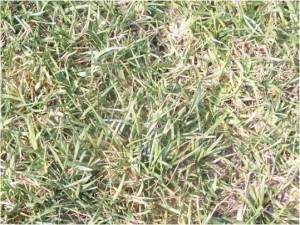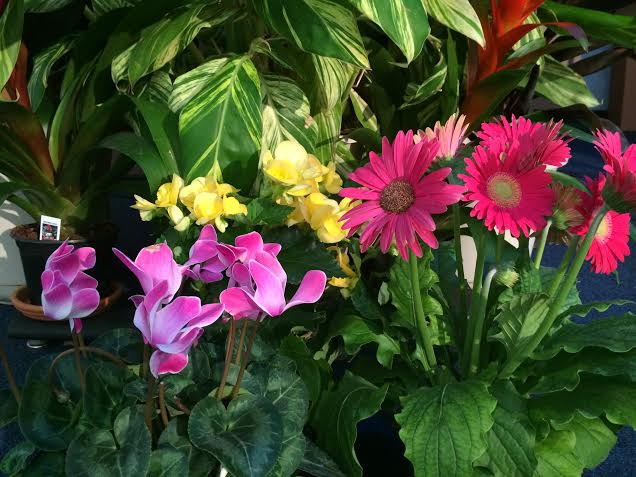
by Mary Salinas | May 13, 2014

Flowering Houseplants. UF IFAS photo by Mary Derrick.
Plants add color, interesting textures and, of course, beauty to our indoor living environments. The air is freshened with the oxygen they provide.
Keep them healthy by watering correctly. Plants have differing water requirements so take a moment to look up some good research-based information on your particular plants and find out what kind of watering regime is best for them. For most houseplants, it’s time to water when the top inch or so of soil is dry to the touch. Some do best when they dry considerably before watering, like succulents, while others, like cineraria, like to stay evenly moist. It may help to group your plants by their water requirements so you can better remember and manage their watering needs.
When it is time to water, make sure to water thoroughly so that excess water drains from the pot. There are several really good reasons to follow that practice. First, a thorough watering allows all the soil and roots to be moistened and you avoid having dry spots in the soil. Also, when the excess water drains, it takes with it the excess salts from fertilizers. When excess salts build up over time, the roots can be damaged and the plant can eventually die. One of the first plant symptoms is brown, dead tips of the leaves. A definitive sign of excess salt is a white mineral build up around the inside edges of the pot or on the surface of the soil. If you already have a salt build-up, you can water heavily a few times to help leach the salts or re-pot your plant with some fresh potting soil.
One last tip – once you water your plants, don’t let the pots and the roots sit in water. Dump out any standing water.
For more information, please see:
Solutions for Your Life: Houseplants
Gardening Solutions: Salt Build-up in Houseplants
Virginia Extension: Indoor Plant Culture
by Sheila Dunning | Nov 11, 2013

It doesn’t take expert gardeners or landscapers to create a Florida-friendly yard. All it takes is a willingness to learn and a desire to build a beautiful yard that helps protect Florida’s environment. Florida-friendly landscaping is now part of state law. Florida Statute 373.185 prohibits government entities and homeowners associations from enacting or enforcing any governing document to prevent homeowners from implementing Florida-friendly landscaping (FFL) principles. A guideline to ease the development of a manual can be found at this link on the Florida Yards and Neighborhoods website. “Florida-Friendly Landscape Guidance Models for Ordinances, Covenants, and Restrictions.” 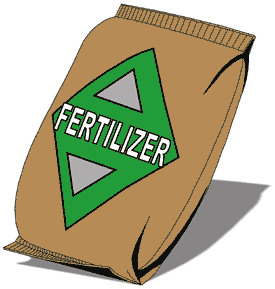 Florida Statutes 482.1562 states that all commercial fertilizer applicators must have a license from the Florida Department of Agriculture and Consumer Services (FDACS) by January 1, 2014. To get this license, each Green Industry employee must be trained in Best Management Practices, which teaches professionals how to implement FFL principles. Additionally, to address water conservation Florida Statute 373.62 says the following: “Any person who operates an automatic landscape irrigation system shall properly install, maintain, and operate technology that inhibits or interrupts operation of the system during periods of sufficient moisture, regardless of when the system was installed”. Irrigation contractors are required by law to ensure that there is an operational rain shut off device on site before they can perform any services. If it doesn’t exist or isn’t working, the contractor can be fined for not reporting the property owner or by completing the repair work without installing or repairing the rain shut off device.
Florida Statutes 482.1562 states that all commercial fertilizer applicators must have a license from the Florida Department of Agriculture and Consumer Services (FDACS) by January 1, 2014. To get this license, each Green Industry employee must be trained in Best Management Practices, which teaches professionals how to implement FFL principles. Additionally, to address water conservation Florida Statute 373.62 says the following: “Any person who operates an automatic landscape irrigation system shall properly install, maintain, and operate technology that inhibits or interrupts operation of the system during periods of sufficient moisture, regardless of when the system was installed”. Irrigation contractors are required by law to ensure that there is an operational rain shut off device on site before they can perform any services. If it doesn’t exist or isn’t working, the contractor can be fined for not reporting the property owner or by completing the repair work without installing or repairing the rain shut off device.
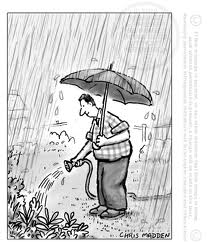 Fertilizing Appropriately and Watering Efficiently are just two of the nine Florida-friendly landscaping principles. Right Plant, Right Place; Mulch, Attracting Wildlife, Managing Yard Pests Responsibly, Recycling, Reducing Stormwater Runoff and Protecting the Waterfront.are the other principles. Utilizing landscape techniques that reduce the inputs that can negatively impact natural resources is the foundation of Florida-friendly landscaping. By implementing the practices, the user saves money, reduces their workload and protects the environment. Many of the Florida-friendly landscaping principles are common sense applications. For more information visit the Florida Yards website.
Fertilizing Appropriately and Watering Efficiently are just two of the nine Florida-friendly landscaping principles. Right Plant, Right Place; Mulch, Attracting Wildlife, Managing Yard Pests Responsibly, Recycling, Reducing Stormwater Runoff and Protecting the Waterfront.are the other principles. Utilizing landscape techniques that reduce the inputs that can negatively impact natural resources is the foundation of Florida-friendly landscaping. By implementing the practices, the user saves money, reduces their workload and protects the environment. Many of the Florida-friendly landscaping principles are common sense applications. For more information visit the Florida Yards website.
by Sheila Dunning | Aug 23, 2013
At the halfway point through 2013, cumulative rainfall amounts for the calendar year were near normal, on average, across the Northwest Florida Water Management District. January, March and May were rather dry. Yet, February, April and June had an abundance of rain. Then, in early July, an unusual persistent mass of moist tropical air brought intense rainfall to the Florida Panhandle. Instead of fireworks on the Fourth of July, most places had record rain. The flooding resulted in washed out roads, drown peanuts and exploding watermelons.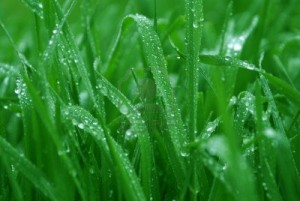
Yet, many landscape sprinkler systems were still running. One has to ask, “Where are all the rain shut-off devices?”. Florida is one of just a few states with a rain sensor statute. Since May 1991, new installations of irrigation systems have been required to include a rain shut-off device. However, no wording was included to cover installation or maintenance. The 2010 statute change now states the following: “Any person who operates an automatic landscape system shall properly install, maintain and operate technology that inhibits or interrupts operation of the system during periods of sufficient moisture.” (Florida Statute 373.62).
Thus, ALL automatic landscape irrigation systems require rain sensors, or other shut-off devices such as soil moisture sensor irrigation controllers. No “grandfather clause” was included for existing systems. Regardless of when it was installed, every sprinkler system must have an operational rain shut-off device. Irrigation contractors can be fined for working on a system without checking out and/or connecting a device.
Moisture sensing technology conserves water, saves money, reduces wear on irrigation system components, reduces disease and helps protect water resources from runoff. Previous research has shown that homeowners using in-ground, automatic irrigation systems, typically in Florida, apply 47% more water for landscape irrigation than homeowners without automatic irrigation systems. This over-irrigation is largely due to a “set it and forget it” mentality despite seasonal fluctuations in plant water needs. If the water costs and the amount of water applied per watering cycle are known, it is easy to calculate how much money is being saved each time the sensor interrupts the program. For example, if a system irrigates ½ acre of turf and is set to deliver ½ inch of water to each zone, approximately 13,576 gallons of water will be used during each watering event. If the cost of the water is $2.00 per thousand gallons, every time the sprinkler system comes on the water bill will be $27.15. A significant amount of money and water can be saved by maintaining a rain shut-off device.
 Irrigation is common in Florida landscapes because of sporadic rainfall and the low water holding capacity of sandy soils. Water conservation is a growing issue due to increased demands from a growing population. The least expensive and most common rain sensor device is the expansion disk rain shut-off. Expanding cork disks trigger a pressure switch. The expansion space can be easily adjusted by rotation of the disk cover to a predetermined amount of rain required to trigger the switch. The amount of rain that will interrupt the irrigation system is marked on the adjustment cap. A rain sensor must be mounted where it will be exposed to unobstructed rainfall, typically installed near the roofline on the side of a building.
Irrigation is common in Florida landscapes because of sporadic rainfall and the low water holding capacity of sandy soils. Water conservation is a growing issue due to increased demands from a growing population. The least expensive and most common rain sensor device is the expansion disk rain shut-off. Expanding cork disks trigger a pressure switch. The expansion space can be easily adjusted by rotation of the disk cover to a predetermined amount of rain required to trigger the switch. The amount of rain that will interrupt the irrigation system is marked on the adjustment cap. A rain sensor must be mounted where it will be exposed to unobstructed rainfall, typically installed near the roofline on the side of a building.
Irrigation control technology that improves water application efficiency is now available. Soil moisture sensors (SMS) can reduce the number of unnecessary irrigation events. Most soil moisture sensors are designed to estimate soil volumetric water content based on the soil’s ability to transmit electricity, which increases as the water content of the soil increases. Bypass type soil moisture irrigation controllers use water content information from the sensor to either allow or bypass scheduled irrigation cycles on the irrigation timer. Another type of control technique with SMS devices is “on-demand” where the controller initiates irrigation at a low threshold and terminates irrigation at a high threshold. A single sensor can be used to control the irrigation for many zones or multiple sensors can be used to irrigate individual zones. In the case of one sensor for several zones, the zone that is normally the driest, or most in need of irrigation, is selected for placement of the sensor in order to ensure adequate irrigation in all zones. Sensors should be buried in the root zone of the plants to be irrigated. For turfgrass, the sensor should typically be buried at about three inches deep. The placement of SMS should be at least 5 feet from hard surfaces and sprinkler heads. The sensor needs to be calibrated and/or the soil water content threshold needs to be selected.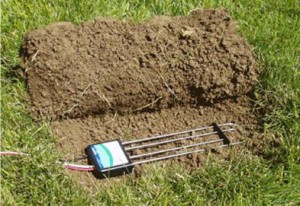
The amount of water that can be saved using rain shut-off devices is substantial. Since the end of March, groundwater levels in the coastal Floridan aquifer shows a slight decline, primarily due to increased pumping from higher seasonal populations during the spring and summer months. In the western panhandle, groundwater levels in the Sand and Gravel aquifer are below normal, which indicates that infiltrating recharge from the above normal rainfall has yet to reach the water table. Remember that every drop that hits the ground will be picking up pollutants as it flows to our groundwater. Nonpoint source pollution is the leading cause of water quality problems. These pollutants have harmful effects on drinking water supplies, recreation, fisheries and wildlife.
By only irrigating when the soil needs it, you are also preventing contamination of drinking water.
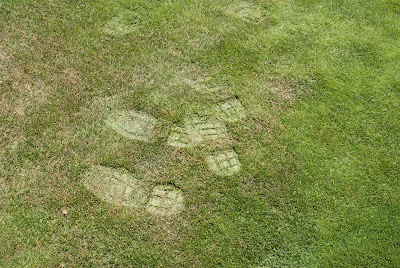
by Taylor Vandiver | Jul 15, 2013
Turfgrass, like all plants, requires water for growth and survival. With the weather we’ve been having lately, watering your lawn is probably the last thing on your mind.
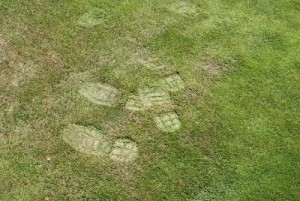
Footprints in turfgrass are a common symptom of drought stress. They are the result of a loss in turgor pressure, due to lack of water, in plant tissue.
However, without sufficient rainfall, water to home lawns will need to be supplemented with irrigation. The most efficient way to irrigate or water your lawn is to apply water only when the lawn starts to show signs of drought stress from lack of moisture.
A few signs associated with drought stress include the changing of turfgrass color from green to a bluish-gray, or white cast. Another sign could be “footprints” on the lawn. If walking across a lawn late in the afternoon causes footprints to be left behind, the lawn may need watering. When feet compress the leaf blades of the turfgrass, the low water levels in the plant tissue prevent the leaf blades from recovering, or “springing” back up, after being pushed down. If the footprints remain for an extended period of time, water the lawn to prevent the turfgrass from turning brown and becoming dormant. The visual condition of the turfgrass can also be used to evaluate drought stress. Turfgrass blades respond to drought stress by folding, rolling, and/or wilting.
A recommended application of ½ to ¾ inch of water can be applied when your turfgrass begins to show the drought stress symptoms discussed previously. Once this amount of water is applied, do not apply again until drought is noticeable. If it rains, like it has been lately, hold off on irrigating until visible drought stress symptoms appear.
Irrigation frequency can vary based on grass species, rainfall amounts, soil type and amount of compaction, shade presence, location, etc. There is a fine line between under and over watering a lawn. Over watering can cause problems such as poor root growth and susceptibility to disease. Over watering can also increase the presence of weed species. When watering, avoid applying water to the point of runoff. Allow the water to soak into the lawn and soil. The optimal time of day to water lawn grass is during the early morning hours. If irrigation is done during the day that water is being lost to higher evaporation rates. Watering in late afternoon or late morning may be detrimental if it extends the time the lawn is naturally wet from dew. This extended “dew period” may increase disease presence in turf.
Automated irrigation systems are convenient, but can have flaws. Always check to make sure your system is working properly and is applying the correct amount of water. However, if significant rainfall has fallen for the week, the automated timed irrigation systems can be turned off so water is not wasted.
Once turf has been watered, it should not be watered again until similar drought stress symptoms are observed. It is never suggested to water your lawn every day, unless it is in the establishment phase or renovations are occuring. Proper watering techniques are key to creating a happy and healthy lawn.
by Larry Williams | May 30, 2013
When Northwest Florida goes through a dry period in spring or summer, many gardeners wonder about some mysterious pest that’s playing havoc in their lawns.
Without realizing it, the gardener is observing dry spots which they are mistaking for a lawn pest. These dry spots are the result of imperfections in an irrigation system. They’re revealed during times of inadequate rain. During times of sufficient rainfall, rain masks the irrigation system’s imperfections. There are many imperfect sprinkler systems. Click on the link below to read entire article and for a couple of simple tests that can help determine if the problem areas are to be blamed on lack of water versus some mysterious pest. Don’t Blame Pests for Dry Lawn
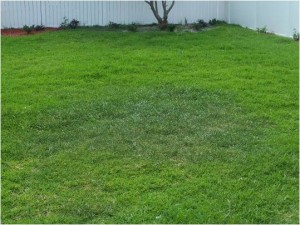
Dry Area in Lawn
